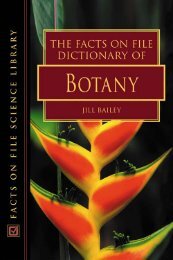You also want an ePaper? Increase the reach of your titles
YUMPU automatically turns print PDFs into web optimized ePapers that Google loves.
1.6<br />
1.6 L}'copusicon e$culentum (tomato} fruit. In T$ the<br />
numerous seeds (1) are seen attached to axial placentas (2)<br />
and embedded in juicy tissue derived from placental tissue.<br />
The four locules indicate that the fruit developed from an<br />
OV3£}" of four fused carpels. In the external view the<br />
remains of the flower stalk and the green sepals (3) are<br />
...isible at irs base; this fleshy fruit developed from a single<br />
superior ovary which was situated alxl\'c the p:rianth.<br />
1 S=h<br />
2 Axial placentas<br />
3 Sepals<br />
1.8 LS of [he heterosporous conc of Selagineffa (a fern<br />
ally). The sporangia are borne in the angle between the<br />
cone: axis and the sporophylls (l). Within the sporangia the<br />
spore mother cells undergo meiosis: the mcgasporangia<br />
comain a few large and thick-walled haploid mq;aspores<br />
(2}, while the microsporangia comain abundant small and<br />
thin-walled mkrospores (3).<br />
Note the small ligules (4) on the adaxial surface of the<br />
sporophylls; this feature shows the affmity of present day<br />
Sdaginella with the fossil Lepidodendron, the dominant<br />
tree of the Carboniferous coal measures. (LM x 35.)<br />
1 Sporophyll<br />
2 Megaspores<br />
3 Microspotes<br />
4 Ligule<br />
1.7 Portion of a withered fenile frond (leaf) of the subnopical<br />
nee feen Dicksoni4 QntQrtiCD. The multitudinous<br />
sporangia on its ahaxial surface have dehisced and shed<br />
billions of yellow, uniform-sized, haploid spores onw the<br />
bench surface.<br />
13<br />
1.7<br />
1.8





